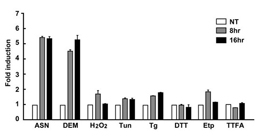Research Abstract
酸化ストレスをモニタリングするためのトランスジェニックマウスモデル
A transgenic mouse model for monitoring oxidative stress
2012年1月19日 Scientific Reports 2 : 229 doi: 10.1038/srep00229

酸化ストレス条件は、さまざまな刺激に由来する活性酸素種の産生を亢進し、神経変性疾患や炎症、種々のがんなどの多様なヒト疾患と関連する。これまでに動物モデルを用いて、このような関連性についての研究が詳細に行われてきたが、酸化ストレスをモニタリングするためのin vivoシステムはまだない。我々は、Keap1-Nrf2経路における転写レベルの誘導と翻訳後レベルのタンパク質安定化によって、二重に制御される酸化ストレスインジケーターを開発した。in vitroにおいて、このインジケーターはKeap1-Nrf2依存的な様式で、さまざまな試薬のうち酸化ストレスに対して、強く特異的なシグナルを示した。さらに、このインジケーターを発現するトランスジェニック動物は、酸化ストレスに対して著しいシグナルを示した。以上の結果は、我々のシステムがin vitroとin vivoの両方における酸化ストレスのインジケーターとして有効であることを示している。
- 群馬大学 先端科学研究指導者育成ユニット
- 理化学研究所 基幹研究所
- 独立行政法人 日本学術振興会
- 独立行政法人 科学技術振興機構
Oxidative stress conditions enhance the production of reactive oxygen species resulting from a variety of stimuli, and are associated with various human diseases, including neurodegenerative disorders, inflammation, and various cancers. Though such associations have been closely studied using animal
models, there has been no in vivo system for monitoring oxidative stress. We have developed an oxidative stress indicator that is dually regulated by induction at the transcriptional level, and by protein stabilization at the post-translational level in Keap1-Nrf2 pathway. In vitro, our indicator elicited an intense and specific signal to oxidative stress among various agents, in a Keap1-Nrf2-dependent manner. Moreover, the transgenic animal expressing the indicator exhibited significant signals upon oxidative stress. These results indicate the usefulness of our system as an indicator of oxidative stress both in vitro and in vivo.

